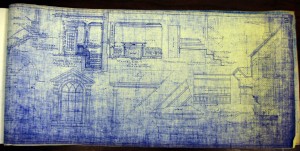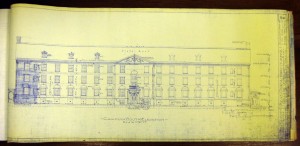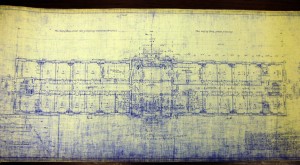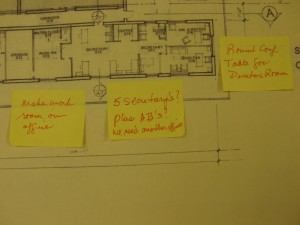Cataloging Blueprints
I'm a junior at the College of William and Mary, and I started cataloging blueprints in the Special Collections Research Center in the Fall of 2009. Most of the blueprints are of buildings on the campus, but many other places are represented too; I have cataloged dozens of blueprints from Eastern State Hospital, some off campus houses that have become administrative buildings, and a few surveys of the College's ownings as a whole.
What is "cataloging" you ask? It's more fun than it sounds. It starts with boxes of rolled, often worn and tattered blueprints from the somewhat mysterious archives. One-by-one, I unroll and unfurl the pages and start to assess the situation. I will walk you through the steps of cataloging a single document as an example of the questions I ask myself and the methods I use:
1) Is this thing going to fall apart on me? I've cataloged documents dating back to the late 17th century, so this question biases not only how frightened I am of somehow destroying a priceless document (unlikely), but more importantly how tenderly I leaf through the pages of the print. Does it have tears, stains or fading? Has someone tried to repair it? I've learned that many adhesives are not archival, or suitable to be stored away for a long time without damaging the document. The term "acid-free" is thrown around often when describing archival quality materials because acid, along with mold, is a worthy adversary in the fight against aging. Is it in good enough condition to handle? Yes, proceed to step 2.
2) What does this document depict? I have worked on blueprints, general land surveys (including references to the original placements of the Boundary Stones), furniture arrangements, water drainage systems, and electrical schematics for heating equipment. There is a seemingly endless amount of information needed to construct a building and keep it running. The most common depiction I have come across is blueprints. Blueprints can include floor plans, scales (side-views of buildings), placement with reference to other structures, "schedules" of materials to be used in the construction and the cost of those materials, and even detailed drawings of column capitals, cornices, archways and window frames. Sometimes there are copies of blueprints, some of which date back to the 1920s. It is often hard to decipher whether the document I'm looking at is an original blueprint or a facsimile. The name of the structure or plan is often found at the bottom of the page in an information box. This one is a copy of a blueprint of Monroe Hall. It says "Men's Dormitory Number 1" as its title, but I know this to be Monroe because I lived there freshman year.

3) Who created this document? Often, the answer is one of the many College Architects that William & Mary employed in the 20th century like Charles M. Robinson or J. Binford Walford. When the document is a copy or a map, the creator may be a blueprint copying company or a surveyor. (Fun Fact: George Washington received his Surveyor's License from the College of William & Mary in 1749.) The name of the architect or surveyor is often in the same information box as the name of the structure or plot. This blueprint is by Charles M. Robinson, an architect based in Richmond, Virginia.

4) When was this document created? Most of the documents I have worked on can be clumped into two temporal groups; they were created either 1920-1940 or 1978-2000. Buildings in the former category include James Monroe Memorial Hall, the Infirmary (now Althea Hunt Hall), Marshall Wythe Hall (now Reverend James Blair Hall), and plans to "sink" the Sunken Garden. Buildings in the latter category include the Jamestown Residences, additions to Cary Field Stadium (now Zable Stadium), and many renovations to the Dillard Complex. The date is more than likely as a month and a year in the information box at the bottom of the page. This blueprint was made in April 1923.

5) How many sheets are in this document? Many blueprints are 20 or more pages because there is so much information, but sometimes we only have a page or two of the entire set. Furniture arrangements, drainage plans, or land surveys are frequently only a page or two. Each page is called a sheet, and they are often numbered in the corner of the document. This blueprint has 13 sheets.

6) How big is the document? So far they have ranged from about 24"x24" to as much as 72"x84" though I estimate the median to be around 36"x40". For each document, I use a tape measure and record the length and width in inches. This blueprint is 16"x36".
7) What condition is this document in? Most of the documents I have worked on have had a few tears and maybe a piece of tape as an attempted repair. Remember, tape is usually not archival. Some documents have a binding that holds the sheets together, and sometimes that binding has torn completely through. There is very often discoloration and staining on the documents, too. Sometimes, there is a sticker on the document with information about the architect, the building and the date the document was created.  Though these qualities make my job seem more fun because the blueprints and plans look older and more important, it is a little heartbreaking to see the records of our past in such disrepair. This blueprint is good with tears and tape.
Though these qualities make my job seem more fun because the blueprints and plans look older and more important, it is a little heartbreaking to see the records of our past in such disrepair. This blueprint is good with tears and tape.
I enter the answers to these questions into the Special Collections Database under Facilities Management, Blueprints, 1900- . Each document gets its own entry. The last thing I put in the database entry is an accession number. This number is unique to the document and it is in format of Year(dot)EntryNumber. The accession number for this document is 2010.062 because it is the 62nd item to be entered into the catalog in the year 2010. I write the accession number on the back of the last page of the document very lightly in pencil, so the document is physically linked to its accession number.
Finally I do my small part to preserve the document. I either put it in an acid-free box, when available, or I roll it in a sheet of acid-free paper and tie it up with acid-free string. (I knew those years of knot-tying in Boy Scouts would come in handy some day!) When the document is safe in its acid-free cocoon, I take it down to Special Collections closed stacks and put it on the shelf in order by accession number with the other blueprints.

The final catalog entry for this blueprint of Monroe Hall is Item 161 here.
There are hundreds of blueprints in our collection. Many came to Special Collections in various states of disrepair, and we do our best to preserve them. Ideally, there would be digital copies made of every blueprint so the originals are handled as infrequently as possible. We do not have the resources to do that yet, but we are digitizing as many other parts of the collection as we can.
These blueprints represent the history of the College. Each one tells a story of the origins of a freshman dorm, an academic building long forgotten or any number of other structures which make our campus so "loved of old." These documents are openly available to the public and you should make it a point to come learn a thing or two about the history of your classrooms, your stadiums, and your dorms.
This blog post was originally posted by Cory Chapman on March 26, 2010, and is reposted here because of your editor's mistake. Apologies to Cory and any errors are mine.

